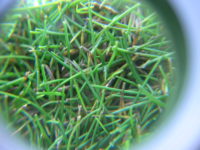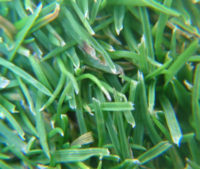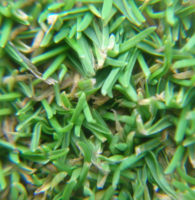Identify grasses*
Identify fine from weed grasses
FineGolf has discovered a new affordable tool to help golfers expose and bring to the light the key issue of the proportion of fine-grasses to weed-grasses in their own club greens.
Question: Why should a golfer want to know about these different grasses?
Answer: The type of grass composition is the major determinant, above all else, as to a green’s playing performance all-the-year-round.
It has been known from the beginning of cool climate golf (which is what we have in GB&I) that fine grasses give more enjoyable golf but if objectively measured proof is needed see this quote:
“Greens dominated by finer grasses offer superior performance.”
from the Sports Turf Research Institute (STRI) five year, objective measurement study of 4,000 greens on some 600 golf courses across the UK. The most comprehensive and largest study ever undertaken, alongside Barenbrug’s project.
In all aspects of smoothness, trueness, high green speed, dryness, firmness, and low thatch content, it was proved that greens with a higher proportion of fine grasses give better outcomes of putting performance and firmness of surface, all-the-year-round, than those dominated by annual meadow grass (Poa annua).
Do you know what grasses are in your greens? Probably not! They all look like the same cut grass to the naked eye!
FineGolf gives you some simple identification tools:
There are three dominant types of golf grasses in GB&I greens (and in other cool climate areas around the world).
They are the Fine Perennial grasses:
1) Fescues
2) Bents (the most relevant one is Browntop Bent, sometimes called Colonial Bent)
And there are the Weed grasses:
3) Annual Meadow grass (Poa annua)
Experts can tell the difference merely by feel and the naked eye, but magnify the leaves by 40 times and anybody can identify the simple differences:
1) Fescues – tiny, thin, rolled leaf
2) Browntop Bent – wider, flatter leaf with multiple rib lines
3) Poa annua – medium-width leaf with a tramline down the middle and a boat-shaped tip.
So, all you need do is go and buy, for about £3,
a jeweller’s loupe with 40 x magnification and Bob’s your uncle!
To see Amazon’s best price CLICK HERE :
The next time you are on the course, put the magnifying glass right up to your eye and then bend down to the grass on the green until it is fully in focus.
FineGolf believes in the power of democracy.
The ordinary golfer’s capacity to recognise these types of main grasses in their Club’s greens, will hopefully make sure that their Club is better held to account. Some Clubs pretend they have more fine grasses than is actually the case.
Support will then be mounted for your greenkeeping team when they come under pressure from any members who might complain that the greens must be cut shorter to give more speed, (perhaps after being influenced by TV’s Augusta Syndrome Disease) rather than concentrating on the much more important performance factor of trueness of roll and the firmness of a ‘running-golf ‘ surface, all-the-year-round.
If golfers identify a high level of weed grasses and low level of fine grasses in their greens, they will perhaps start to realise why they do not putt well and give a soft receptive ‘target-golf ‘ surface for a large part of the year!
It should be remembered that it is easier to promote fine grasses in geological areas with well-draining, less-fertile soils i.e. on links, heath, down and moorland rather than boggy, rich farmland on clay.
Why do fine perform better than weed grasses?
Both in terms of 1) putting performance, 2) cost of maintenance and 3) naturalness of ecology and conservationism, which some call ‘sustainability’.
Fescue dominant greens run fast (the speed depends on the dryness of the grass) and smoothly and are normally cut at 5mm. (never below 4mm or you lose grass cover). Fine grasses have deep roots and need less mowing time, less water, less fertiliser and less pesticides.
Fine grass maintenance gives firmness and putting trueness through-out the year.
Poa annua gives a putt that ‘chatters’ if not cut low and it can be scalped down to 1.8mm to create speed. But the grass with less canopy for photosynthesis becomes stressed, needs even more expensive fertiliser, lots of water as their roots are short and requires more pesticides to stop the stressed grass becoming diseased.
Poa annua produces ‘soft’ greens which in the winter can be like bumpy puddings.
Poa annua, if under stress from lack of expensive fertiliser or water, turns yellow before dieing.
Fine grasses, however, like less-fertile conditions and are drought resistant (they have deep roots). The six weeks of heat of around 30 degrees in the summer of 2018 – the hottest spell since 1976 – did even stress fescues. But during a normal GB&I summer the fine grasses may turn brown in a draught but they do not die and green-up immediately with some rain.
Poa annua is more susceptible to disease than fine grasses, like Fusarium in the winter and Anthracnose in the summer and needs to be sprayed with expensive fungicides to protect it.
Of course there are other grasses found on some golf greens like Rye, creeping bents, velvet bent. None of these would you ideally want on the ‘finest’ golf greens, but they have their place at some courses. There are also other weed grasses like Yorkshire Fog, Cocksfoot, and Timothy and more can be discovered about them at CLICK HERE
A confusion can arise between Rye and Browntop Bent in that the topside of the leaves have similar multiple ribs. Rye though has a glossy fibrous underside and the base of its root is reddish coloured. The tips of the Ryegrass leaves are often shredded as they defie all but the sharpest of mower blades.
Browntop Bent has a ‘rhizome’ stem that creeps sideways underground.
Velvet and Creeping Bents have above-ground, creeping stems and are strong ‘thatch’ producers (as is Poa annua) and require more maintenance than the fine grasses.
Thatch (accumulating organic material from dead grass) creates a soil biology microclimate at the green’s surface that is a perfect environment for the encouragement of Poa annua. Thatch gives soft and boggy greens in winter or even in just wet weather.
A newish process called ‘Compost Teas’ can help encourage good microbes and fungi be contained in the soil that assist in the natural breaking down of the thatch, the picking up of nutrients and the defense from attack by bad bacteria.
Chemical greenkeeping with the use of the addition of systemic fungicides and inorganic-chemical fertilisers that Poa annua needs to survive in golf greens, kill the good microbes and Fungi.
So the most important thing a greenkeeper can undertake is lots of aeration and top dressing (pure washed sand is inert and will not help hold the good microbes and fungi in the soil) to recover the natural soil biology that encourages a more conducive, non-chemical environment for the finer grasses. Without the right balanced, natural soil biology, overseeding with fine grasses is a waste of time and will not work.
If you see any grasses seeding themselves, that will be Poa annua. Fine grasses (fescues/browntop bent) do not self seed when cut at the height of greens.
Poa annua self-seeds all the year round though most strongly in the spring when some Poa annua greens turn almost white! Self-seeding slows the pace of putts and makes them bumpy or ‘chatter’.







Leave a Reply
You must be logged in to post a comment.